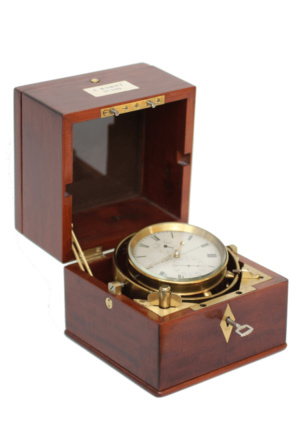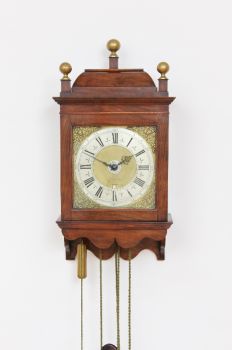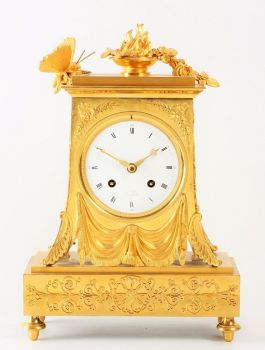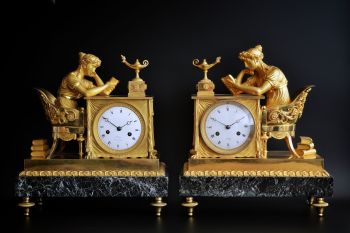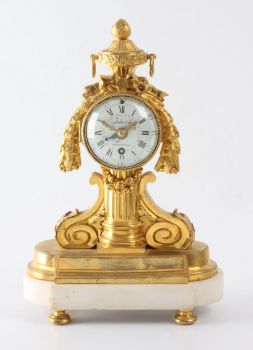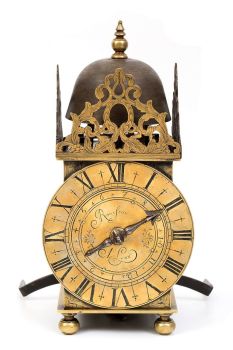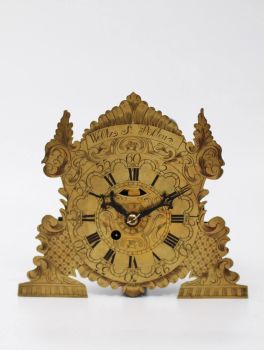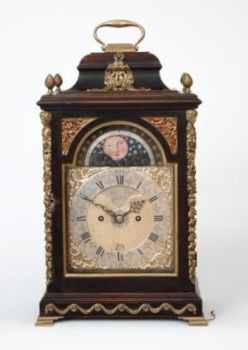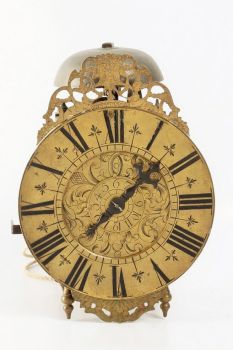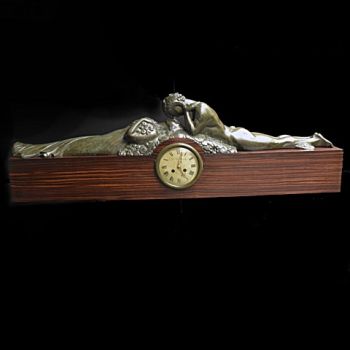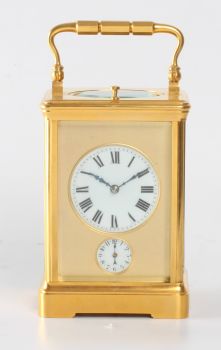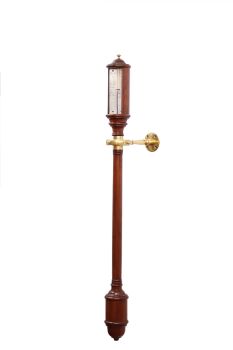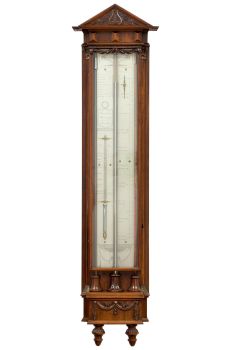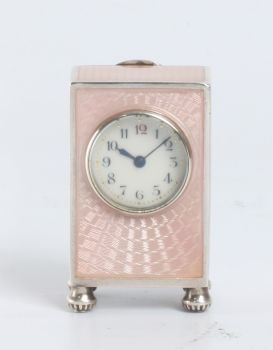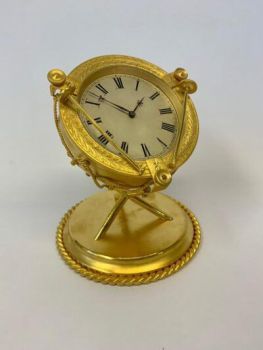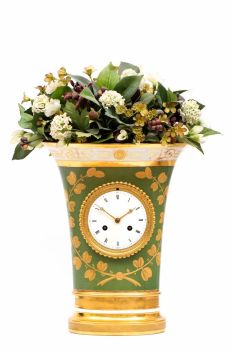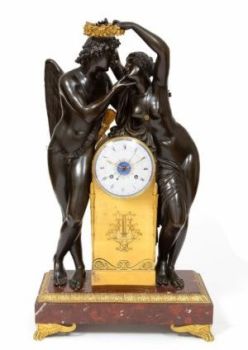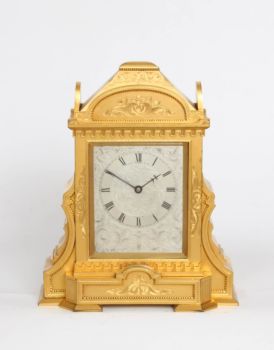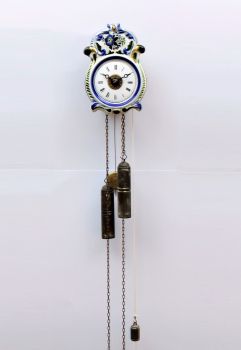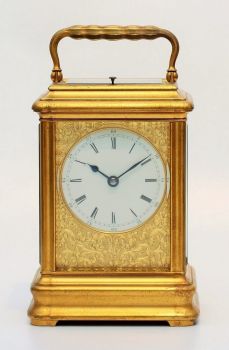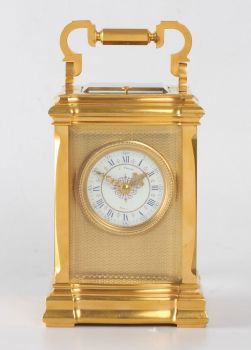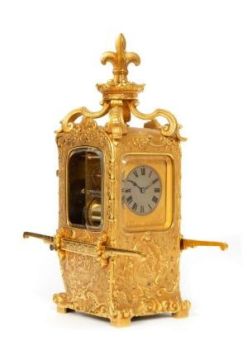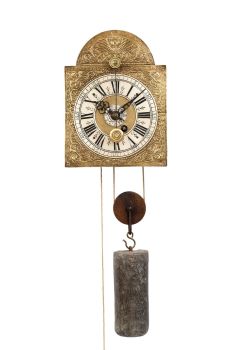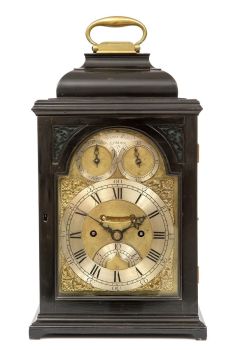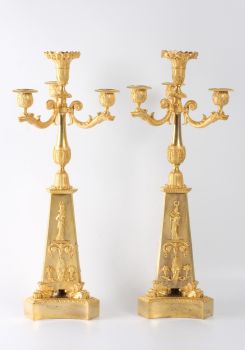A rare Dutch mahogany two-day chronometer by Andreas Hohwü Amsterdam, circa 1865. 1865
Andreas Hohwü
17.50 ⨯ 16.50 ⨯ 16.50 cm
€ 16.500
Gude & Meis Antique clocks and Music Boxes
- Sur l'oeuvre d'artThe dial
The 8.5-cm engraved silvered dial has Roman numerals and is signed No. 519 ANDr. HOHWÜ AMSTERDAM. There are gold spade hands. Below XII there is the subsidiary for power reserve indication (op/af 0-56) showing how long the chronometer still can run before needing to be wound. This function was vital of course since a stopped chronometer would loose its function for navigation. Above VI is the subsidiary seconds hand.
The movement
The well made movement has spotted plates connected by fine ringed pillars. It has a duration of 56 hours and is being driven by a spring barrel with chain and fusee. To keep the chronometer running while being wound there is Harrison’s maintaining power. The rate is determined by a free sprung compensated balance with helical spring in combination with Earnshaw’s detent escapement.
The case
The movement is housed in an extra brass inner case fixed with bajonet fitting. This is fitted in a brass case with the winding hole at the bottom and that is suspended in brass gimbals. Three-tier mahogany case with brass mounts and a plaque to the front signed A. HOHWÜ No. 519.
Andreas Hohwü
Without a doubt Andreas Hohwü was the best chronometer maker Holland has ever had. He was born in Gravenstein (Sleswig-Holstein) in 1803 as the son of Thomas Hohwü a regular clockmaker. He was apprenticed to his father and showed great promise which enabled him to become a student of the famous chronometer maker Kessels in Altona in 1829. Because of his progress he was allowed to go to work and learn at the famous house of Breguet in 1835 where he worked until 1839. In 1840 he started a business under his own name at the Oudeschans Amsterdam. Besides chronometers he also made many precision regulators that were mostly shipped to observatories all over the world. He designed the propulsion of the coastal light houses. After long study he
designed and patented a secondary compensation for middle temperature error. He was awarded by the government with the ‘Knight in the Order of the Oak Crown’ and ‘Knight in the Order of the Dutch Lion’. Internationally he received the ‘Knight Order of Italy’ and the ‘honorary diploma of Vienna’. He also won awards at internaional exhibitions. Andreas Hohwü died in 1885. Lit.; Enrico Morpurgo, Nederlandse Klokken- en horlogemakers vanaf 1300, pp. 59. - Sur l'artisteAndreas Hohwü est né à Gråsten à la frontière germano-danoise en tant que fils de l'horloger Thomas Howhü. Il deviendra plus tard l'apprenti du célèbre horloger hollandais Hendrik Johan Kessels (1781-1849) à Hambourg. Par la suite, il s'installe à Paris pour travailler pour l'horloger Louis Breguet (1804-1883) jusqu'en 1840, date à laquelle il part pour Amsterdam pour créer sa propre entreprise. Il a fabriqué des horloges à pendule et des garde-temps chronométriques et a reçu deux titres honorifiques néerlandais pour ses pratiques en atelier.
Êtes-vous intéressé par l'achat de cette oeuvre?
Artwork details
Catégorie
Related artworks
Artiste Inconnu
Set Franse Empire Pendules / Empire Lectura penduleearly 19th
Prix sur demandeKuipers Kunst & Antiek
Artiste Inconnu
A Surinam-themed Amsterdam long-case clock1746 - 1756
Prix sur demandeZebregs & Röell - Fine Art - Antiques
 Sélectionné par
Sélectionné parGallerease Magazine
Artiste Inconnu
Engels struttclock gesigneerd H.Rodrigues 42 Piccadilly 19th century
Prix sur demandeNico van den Assem restauratie
1 - 4 / 24- 1 - 4 / 12

